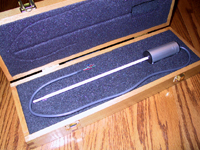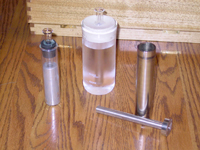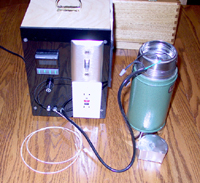Platinum Thermometer
I have several digital
thermometers that give readings in 10ths of a degree but differ by
whole degrees. It's a classic case of the difference between accuracy and
precision. The situation persisted for a number of years, until
Scientific American ran a series of articles
in the Amateur Scientist column by Shawn Carlson that started
me thinking about calibrating the thermometers. This note is a work in
progress and documents the approach I am using and the minor obsession the
search for the ideal thermometer has become.
The articles are available online - see
A Homemade High-Precision Thermometer
Tackling The Triple Point
Calibrating With Cold
The Thermometer
The first article above documents the design of a platinum sensor based
thermometer. High quality platinum thermometers, called Standard Platinum
Resistance Thermometers or SPRTs are used by national standard labs to keep
the temperature standards. A thermometer that is "traceable to NIST" is
traceable to an SPRT. Platinum's resistance to an electrical current changes
in a predictable, repeatable way over a very large temperature range.

You can click on any of the images to see a bigger version.
|
I set out to build the thermometer.
I ordered the glass for the tube from James Finley
at GlassWorks in Bartlesville, OK. James is a great guy to work with - he's
very patient with newbies like me and even sent some of the small glass
beads referred to in the Sci Am article. The tube set me back all of $20.00.
I got the platinum element from
Omega Engineering for about $30.00.
The handle is 1.25"
aluminum tubing from Home Depot with a couple of small wooden ends turned from
rosewood that I happened to have laying around. Inside the handle are wires
and an aluminum "donut" slit with a set-screw to pull it together. There is a
bit of vinyl tubing between the donut and the glass.
Calibration, part 1
It really works pretty well. I have a 6 1/2 digit HP DVM (ebay) that allows
me to measure the resistance. It really does change at about 3.85 degrees per
degree C, as well as I can determine. It's supposed to be 1000 ohms at 0
degrees C.
I read somewhere that I can calibrate it with an ice bath. Sounds easy, just
get some ice, get some cold water, stir, stick in the thermometer. Watch it
change. If you check out the graph you'll see the
thermometer cool on a nice log curve just like it should and then mysteriously
start to rise. Wonder why it's rising? No matter how many times I
repeated the run I got similar results. Still don't know why.
Great. I'm now in about the same shape as my cheap
electronic thermometers. Lots of resolution, no accuracy
Shawn had already told me how to fix this problem even though
I spent some time in denial. Need to build a triple point
of water cell.
 Left to right: mercury, water and tin cells
Left to right: mercury, water and tin cells
|
But that's actually easier said than done. After breaking
a few test tubes, buying random flasks (I said I am a newbie...) and digging
around on lab glass web sites, I ended up with a 300mm "Fast-Freeze Flask
Bottom" #75426-00 from
Labconco
that I found on ebay. Great place, ebay.
Got it for a couple of bucks.
The drying flask is meant to be used under a vacuum so it is heavy glass,
it is meant to be frozen so it is made of pyrex or a close relative thereof and
it has a wide mouth so you can make nice big ice mantles.
James Finley made a thermometer well to put in it.
Now we're in business.
Check out THIS graph.
But nothing's ever easy. I found after a few runs and refinements that
the thermometer has a bit, I currently estimate 0.42 ohms, of self-heating
from the current flowing through the element.
I calculated the estimate by measuring the temperature at two different
current levels, 1 mA and 0.1 mA, and figuring the "zero current" reading.
I found the Callendar-Van Dusen Equation. It allows one
to model the non-linearities in a platinum sensor. It's a nice polynomial
that needs only 4 (4?) coefficients. I just got R0. Only need A, B and C.
Calibration, part 2
I got a mercury cell from
The Society for Amateur Scientists.
I had James make another thermometer well because the one that
comes with the SAS cell is too small for the 8mm thermometer stem.
An initial run shows a promising plateau but I haven't refined my
methods enough to share the results. I hope I can get another
coefficient with it.
With an accurate barometer and a bit of math
(see the
Boiling Point of Water Calculator)
I can use the boiling point of water for the third coefficient. Really haven't
spent much time with it yet either but it looks good so far. Now I just need
one more coefficient.
The metal cell in the picture above is hopefully a melting point of
tin cell. It is the same theory as a melting point of mercury cell but
works at 231 degrees C rather than -38 degrees C.
I got some "99.99% pure tin" from a casting house ($6.00/kg)
and turned the cell from stainless steel on a small metal lathe.
The pros use metal or glass cells sealed
to the outside air and lined with a carbon crucible. They also use
99.9999+ (also known as 6 nines) pure metal. Costs hundreds of dollars
per ounce. I thought I'd give it a try with the $6.00 stuff
and see what I could see.
Just need something to melt it in. Shawn comes through again with
A Furnace In A Thermos.
A Small Furnace
 A home made furnace for small things
A home made furnace for small things
|
The box on the left contains a
temperature controller
from Omega (ebay $60.00), a fuse, a ground fault socket and a switch.
Coiled in front of it is another RTD for the controller's use. The thermos
contains a heat rope (local surplus house, $1.50) wrapped around an aluminum
core. The controller works remarkably well. It will easily hold the
setpoint temperature at plus or minus 1 degree. The core is bored out enough
to admit the stainless cell.
 You can see a ways inside it here:
You can see a ways inside it here:
|
Current Status
Here's where I'm currently am: when you melt tin you get a bunch of tin
oxide on the surface - I tried it on the stove. Must be why the pros use
the sealed cells. I'm currently trying to come up with a (cheap) way to
flood the furnace with argon or nitrogen when I heat the cell. Somehow
buying high pressure tanks on ebay doesn't seem like
a good idea, even though I found a few.
Current Open Questions
How pure is the tin?
How pure is the mercury? What do "ACS" and "regent" mean, anyway?
How accurate is the steam bath?
Does the self-heating depend on the material the thermometer is in?
All leading up to: what kind of error bands will I end up with?
Why isn't the simple ice bath more repeatable?
Will I fill the house with stuff or run out of money first?
Contact Information
You can reach me at r.bond@verizon.net
or rgb@ncube.com


 Left to right: mercury, water and tin cells
Left to right: mercury, water and tin cells
 A home made furnace for small things
A home made furnace for small things
 You can see a ways inside it here:
You can see a ways inside it here: